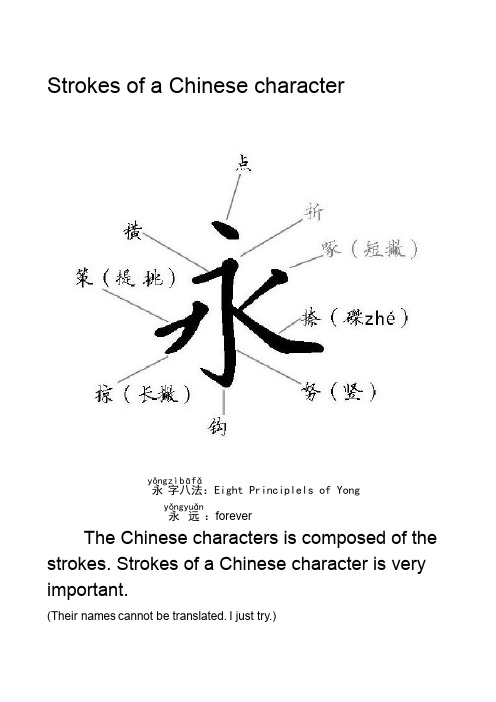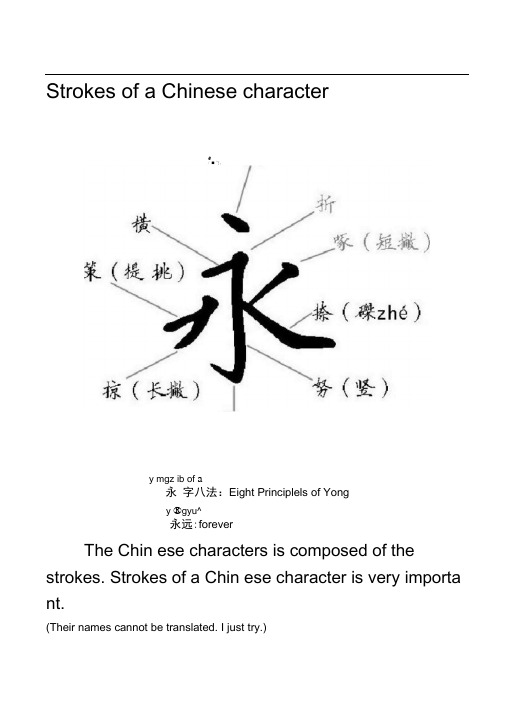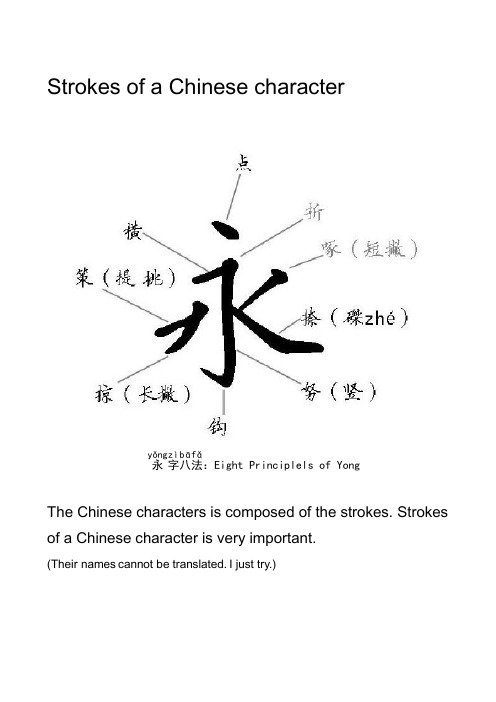汉字笔画英文翻译
- 格式:doc
- 大小:774.00 KB
- 文档页数:4

点击查看》》2021英语四级翻译练习题题库请将下面这段话翻译成英文:中国独有的文书工具(calligraphic tools),即笔、墨、纸、砚(ink stone),被称为“文房四宝"(Four TreasuresoftheStudy)。
从名称上,我们不难看出中国的书法家和画家珍视它们的程度。
尽管这四种工具已经发生了演变,人们仍然相信,如果不使用传统的文房四宝,中国艺术作品就出不了杰作。
其他东方国家也继承了中国的这个传统,比如日本。
也许这就是为什么日本书法和绘画与中国书法和国画很相似的原因。
参考翻译:Chinese particular calligraphic tools includebrush,ink,paper and inkstone,which are known as"Four Treasures of the Study”.We can easily tellhowChinese calligraphers and painters value them fromthe name.Despite theevolution of the four tools,itis believed that no Chinese artwork can be amasterpiece without using the traditional fourtreasures.Other oriental nationssuch as Japan has inherited this Chinese tradition.Maybe that'swhy Japanesecalligraphy and Japanese painting resemble Chinese calligraphy andChinesepainting.1.尽管这四种工具已经发生了演变,人们仍然相信,如果不使用传统的文房四宝,中国艺术作品就出不了杰作:“演变”可译为evolution。

Strokes of a Chinese character永y ǒng 字z ì八b ā法f ǎ:Eight Principlels of Yong永y ǒng 远yu ǎn :foreverThe Chinese characters is composed of the strokes. Strokes of a Chinese character is very important.(Their names cannot be translated. I just try.)精品文库点di ǎn ——dot , 即j ítiny dash 。
横h éng——horizontal ,即rightward stroke 。
竖sh ù——vertical ,即downward stroke 。
撇pi ě——throw away OR left-falling ,即falling leftwards ,with slight curve ,not very curved 。
捺n à——press down OR right-falling ,即falling rightwards, flattening at the bottom 。
提t í——rise OR rising ,即flick up and rightwards ,taper 。
撇点pi ědi ǎn ——throw away - dot竖提sh ùt í——vertical – rise折——break OR turning ,即90 degree turn ,going down or going right only 。
横折提h éngzh ét í——horizontal- break- rise 弯w ān——bend ,即usually concave on the left 。

Strokes of a Chinese character占/ ■ "!、y mgz ib of a永字八法:Eight Principlels of Yongy ®gyu^永远:foreverThe Chin ese characters is composed of the strokes. Strokes of a Chin ese character is very importa nt.(Their names cannot be translated. I just try.)折 --- break ORturning ,即 90 degree turn , going downor going right only 。
h engzh & i 横折提 ---- horiz on tal- break- risewoi弯 --- b en d , 即 卩 usually con cave on the leftsh iwaig cu竖弯钩 ---- vertical- bend- hookxi e斜 --- s la nt ,即 usually con cave on the right1即tinydi d n 点 ----dot , h e g横 ---- horizontal ,即 rightward stroke 。
sh u竖 --- vertical ,即 downward stroke 。
throw away OR left-falli ng,即 falling leftwards , withslight curve , not very curved 。
n a 捺 -- press dow n OR right-falli,即 falling rightwards,flattening at the bottomt i 提 -- rise OR rising ,即 flick up and rightwards , taper 。

48个基本笔画可复制粘贴英文回答:The 48 basic strokes are essential for anyone learning to write Chinese characters. These strokes are the building blocks of the characters and understanding them is crucial for proper character formation. Here are the 48 basic strokes:1. Horizontal stroke: 一(yī)。
2. Vertical stroke: 丨(gǔn)。
3. Left-falling stroke: 丿(piě)。
4. Right-falling stroke: ㇏(héng)。
5. Dot: 丶(diǎn)。
6. Hook: 乛(gōu)。
7. Horizontal hook: 乚(yǐ)。
8. Vertical hook: 乙(yǐ)。
9. Left hook: 乜(miē)。
10. Right hook: 乛(gōu)。
11. Left-slanting stroke: 乙(yǐ)。
12. Right-slanting stroke: 乙(yǐ)。
13. Left-falling and right-slanting stroke: 乛(gōu)。
14. Right-falling and left-slanting stroke: ㇏(héng)。
15. Left-falling and left-slanting stroke: 丿(piě)。
16. Right-falling and right-slanting stroke: 一(yī)。
17. Horizontal and vertical stroke: 十(shí)。

Strokes of a Chinese character永y ǒng 字z ì八b ā法f ǎ:Eight Principlels of YongThe Chinese characters is composed of the strokes. Strokes of a Chinese character is very important.(Their names cannot be translated. I just try.)点di ǎn ——dot , 即j ítiny dash 。
六横h éng——horizontal ,即rightward stroke 。
大竖sh ù——vertical ,即downward stroke 。
十撇pi ě——throw away OR left-falling ,即falling leftwards ,with slight curve ,not very curved 。
八捺n à——press down OR right-falling ,即falling rightwards, flattening at the bottom 。
八提t í——rise OR rising ,即flick up and rightwards ,taper 。
地撇点pi ědi ǎn ——throw away - dot 女竖提sh ùt í——vertical – rise 比折——break OR turning ,即90 degree turn ,going down or going right only 。
横折提h éngzh ét í——horizontal- break- rise 讲 弯w ān——bend ,即usually concave on the left 。

26个大写英文字母的汉字翻译英文字母是我们日常生活中常用的一种字符,而在汉字中,很多英文字母都有相对应的翻译,因此熟悉这些汉字翻译对于学习中文也很有帮助。
下面就一步步介绍26个大写英文字母的汉字翻译。
A -哎哎是一个常用的语气词,表示惊讶、惋惜或者表示不太满意。
例如:哎呀,我忘记做功课了!B -别别表示“不要”、“让开”、“分离”等含义。
例如:别这样做,会受到惩罚的。
C -策策是一个表示计划、方法、主张的词语。
例如:我们要提供更好的策略来解决这个问题。
D -的的是一个常见的助词,表示所属关系。
例如:我家的猫很可爱。
E -俄俄表示与俄罗斯相关事物的概念。
例如:我爱俄罗斯的传统文化。
F -福福表示幸福、吉祥的意思。
例如:祝你福如东海,寿比南山!G -哥哥表示哥哥、兄长等亲属或尊称的意思。
例如:我的哥哥是个牙医。
H -和和表示和睦、和平、一致等的意思。
例如:让我们和平相处吧!I -艾艾是一种用草药制成的植物,也是中草药的一种。
例如:艾叶具有清热解毒的功效。
J -杰杰是一个常用的男性名字,表示英俊、才华出众等的含义。
例如:他是个杰出的演员。
K -凯凯是一个常用的男性名字,表示胜利、辉煌等的意思。
例如:凯旋而归,荣誉归来。
L -勒勒有束缚、限制的意思。
例如:我们要摆脱所有的束缚,追求自由自在的生活。
M -马马是一种动物,也是中国十二生肖之一。
例如:我家庭的宠物是一匹小马。
N -恩恩表示亲切、仁慈、仁爱等的含义。
例如:感谢您的关心和恩惠。
O -哦哦是一个常用的语气词,表示惊讶、赞同、理解等的情感。
例如:哦,原来如此!P -佩佩表示欣赏、仰慕等的情感。
例如:他是一个配得上我们欣赏的好演员。
Q -琪琪是一个常用的女性名字,表示漂亮、美丽等含义。
例如:她是一个非常漂亮的琪琪。
R -儒儒表示文化、学问的意义,也是中国传统的文化形态之一。
例如:儒家思想有着深厚的文化底蕴。
S -思思表示思考、想念、回忆等的含义。
例如:我时常会思念我的家乡。
Strokes of a Chinese character永y ǒng 字z ì八b ā法f ǎ:Eight Principlels of Yong 永y ǒng 远yu ǎn :foreverThe Chinese characters is composed of thestrokes. Strokes of a Chinese character is very important.(Their names cannot be translated. I just try.) 点di ǎn ——dot , 即j ítiny dash 。
横héng——horizontal ,即rightward stroke 。
竖shù——vertical ,即downward stroke 。
撇pi ě——throw away OR left-falling ,即falling leftwards ,withslight curve ,not very curved 。
捺nà——press down OR right-falling ,即falling rightwards,flattening at the bottom 。
提t í——rise OR rising ,即flick up and rightwards ,taper 。
撇点pi ědi ǎn ——throw away - dot竖提shùtí——vertical – rise折——break OR turning ,即90 degree turn ,going down or going right only 。
横折提héngzhétí——horizontal- break- rise 弯w ān——bend ,即usually concave on the left 。
Strokes of a Chinese character永y ǒng 字z ì八b ā法f ǎ:Eight Principlels of Yong永y ǒng 远yu ǎn :foreverThe Chinese characters is composed of thestrokes. Strokes of a Chinese character is very important.(Their names cannot be translated. I just try.)点di ǎn ——dot , 即j ítiny dash 。
横h éng——horizontal ,即rightward stroke 。
竖sh ù——vertical ,即downward stroke 。
撇pi ě——throw away OR left-falling ,即falling leftwards ,withslight curve ,not very curved 。
捺n à——press down OR right-falling ,即falling rightwards, flattening at the bottom 。
提t í——rise OR rising ,即flick up and rightwards ,taper 。
撇点pi ědi ǎn ——throw away - dot竖提sh ùt í——vertical – rise折——break OR turning ,即90 degree turn ,going down or going right only 。
横折提h éngzh ét í——horizontal- break- rise 弯w ān——bend ,即usually concave on the left 。
四六级翻译题(书法、水墨画、剧曲)Calligraphy and Painting书法calligraphy硬笔书法pen calligraphy表音成分phonetic component表形成分symbolic component汉字偏旁components of Chinese characters线条艺术the art of lines汉字书写(体)Chinese script汉字从图画和符号演变而来,中国书法艺术自然而然衍生于这一特殊的书写体系(绝大多数汉字由表音和表形成分构成),因此中国书法也被称作线条艺术。
Chinese characters evolved from pictures and signs, and the Chinese art of calligraphy developed naturally from this special writing system (most Chinese characters consist of several phonetic and symbolic components), so Chinese calligraphy is also called the art of lines.尽管中国书法以汉字为表达工具,但要欣赏中国书法之美,不一定非要懂得汉语。
Although Chinese calligraphy uses Chinese words as its vehicle of expression, one does not have to know the language to appreciate its beauty.书法的目的在于保持自然之美,突显人类精神之美。
Calligraphy’s purpose is to retain the beauty of nature and illuminate man’s spiritual beauty.受到青睐to find favor in汉学圈the circle of Chinese language learning汉学Sinology笔画stroke点、横、竖、撇、折、勾dot stroke, horizontal stroke, vertical stroke, curved stroke, angular stroke, hooked stroke部首,独立成字radical, standalone character篆书,隶书,草书,楷书,行书the seal form, the official form, the cursive form, the regular form, the running form像“字如其人”这样的中国古语与书法是直接相关的。
1. 元宵节:Lantern Festival2. 刺绣:embroidery3. 重阳节:Double-Ninth Festival4. 清明节:Tomb sweeping day5. 剪纸:Paper Cutting6. 书法:Calligraphy7. 对联:(Spring Festival) Couplets8. 象形文字:Pictograms/Pictographic Characters9. 人才流动:Brain Drain/Brain Flow10. 四合院:Siheyuan/Quadrangle11. 战国:Warring States12. 风水:Fengshui/Geomantic Omen13. 铁饭碗:Iron Bowl14. 函授部:The Correspondence Department15. 集体舞:Group Dance16. 黄土高原:Loess Plateau17. 红白喜事:Weddings and Funerals18. 中秋节:Mid-Autumn Day19. 结婚证:Marriage Certificate20. 儒家文化:Confucian Culture21. 附属学校:Affiliated school22. 古装片:Costume Drama23. 武打片:Chinese Swordplay Movie24. 元宵:Tangyuan/Sweet Rice Dumpling (Soup)25. 一国两制:One Country, Two Systems26. 火锅:Hot Pot27. 四人帮:Gang of Four28. 《诗经》:The Book of Songs29. 素质教育:Essential-qualities-oriented Education30. 《史记》:Historical Records/Records of the Grand Historian31. 大跃进:Great Leap Forward (Movement)32. 《西游记》:The Journey to the West33. 除夕:Chinese New Year’s Eve/Eve of the Spring Festival34. 针灸:Acupuncture35. 唐三彩:Tri-color Pottery of the Tang Dynasty/ The Tang Tri-col ored pottery36. 中国特色的社会主义:Chinese-charactered Socialist/Socialist with Chinese characteristics37. 偏旁:radical38. 孟子:Mencius39. 亭/阁:Pavilion/ Attic40. 大中型国有企业:Large and Medium-sized State-owned Enterpris es41. 火药:gunpowder42. 农历:Lunar Calendar43. 印/玺:Seal/Stamp44. 物质精神文明建设:The Construction of Material Civilization and Spiritual Civilization45. 京剧:Beijing Opera/Peking Opera46. 秦腔:Crying of Qin People/Qin Opera47. 太极拳:Tai Chi48. 独生子女证:The Certificate of One-child49. 天坛:Altar of Heaven in Beijing50. 小吃摊:Snack Bar/Snack Stand51. 红双喜:Double Happiness52. 政治辅导员:Political Counselor/School Counselor53. 春卷:Spring Roll(s)54. 莲藕:Lotus Root55. 追星族:Star Struck56. 故宫博物院:The Palace Museum57. 相声:Cross-talk/Comic Dialogue58. 下岗:Lay off/Laid off59. 北京烤鸭:Beijing Roast Duck60. 高等自学考试:Self-taught Examination of Higher Education61. 烟花爆竹:fireworks and firecracker62. 敦煌莫高窟:Mogao Caves63. 电视小品:TV Sketch/TV Skit64. 香港澳门同胞:Compatriots from Hong Kong and Macao65. 文化大革命:Cultural Revolution66. 长江中下游地区:The Mid-low Reaches of Yangtze River67. 门当户对:Perfect Match/Exact Match68. 《水浒》:Water Margin/Outlaws of the Marsh69. 中外合资企业:Joint Ventures70. 文房四宝(笔墨纸砚):"The Four Treasure of the Study" "Brus h, Inkstick, Paper, and Inkstone"71. 兵马俑:cotta Warriors/ Terracotta Army72. 旗袍:cheongsam我们应该拥有的能力:IntellectualSkills1. Honesty (诚实)2. Curiosity (充满好奇)3. Discrimination—ability to distinguish what isimportant fromwhat is trivial(辨别事情的轻重缓急)4. Imagination and creativity5. Common sense6. Dispassion and Objectivity (冷静和客观)7. Systematic problem-solving (系统、条理的处理问题的能力)8. Capacity for logical reasoning,including abstract and theoretical reasoning9. Capacity to draw logical inferences fromobservational and experimental data(从表面现象推导本质问题的能力)CommunicationSkills1. Capacity to retrieve information frompublished sources(提取信息的能力)2. Capacity to communicate in writing (写作中的表达能力)3. Capacity to communicate orally (口头相互交流的能力)4. Skill in use of computers and otherinformation-processing devices5. Skill in graphic display of informationand ideas(用图景表达自己的想法)PersonalityCharacteristics1. Maturity (人格、人生观和价值观的生熟)2. Motivation and drive (自我激励)3. Self-confidence (自信)4. Dependability (值得信赖)5. Independence(独立性)6. Empathy(这个词比较难理解!1、要执着和投入;2、要站在别人的角度考虑当时的问题,不要执着于无畏的争执。
Strokes of a Chinese character
永y ǒng 字z ì八b ā法f ǎ:Eight Principlels of Yong
永y ǒng 远yu ǎn :forever
The Chinese characters is composed of the strokes. Strokes of a Chinese character is very important.
(Their names cannot be translated. I just try.)
精选文档 点di ǎn ——dot , 即j ítiny dash 。
横h éng
——horizontal ,即rightward stroke 。
竖sh ù——vertical ,即downward stroke 。
撇pi ě——throw away OR left-falling ,即falling leftwards ,with
slight curve ,not very curved 。
捺n à——press down OR right-falling ,即falling rightwards, flattening at the bottom 。
提t í——rise OR rising ,即flick up and rightwards ,taper 。
撇点pi ědi ǎn ——throw away - dot
竖提sh ùt í——vertical – rise
折——break OR turning ,即90 degree turn ,going down or going right only 。
横折提h éngzh ét í
——horizontal- break- rise 弯w ān
——bend ,即usually concave on the left 。
钩g ōu ——hook ,即j íappended to other strokes ,going down or going left only 。
弯钩w āng ōu ——bend-hook
竖钩sh ùg ōu ——vertical-hook
竖弯钩sh ùw āng ōu
——vertical- bend- hook 斜xi é——slant ,即usually concave on the right 。
斜钩xi ég ōu ——slant-hook
卧钩w òg ōu ——recline-hook
精选文档 横钩h éngg ōu ——horizontal-hook
横h éng 折zh é钩g ōu ——horizontal- break -hook
横h éng 折zh é弯w ān 钩g ōu ——horizontal- break- bend-hook
横撇弯钩h éngpi ěw āng ōu ——horizontal- throw away- bend-hook
横折折折钩h éngzh ézh ézh ég ōu ——horizontal- break- break- break-hook 竖折折钩sh ùzh ézh ég ōu ——vertical- break- break-hook
竖弯sh ùw ān ——vertical- bend
横折弯h éngzh éw ān ——horizontal- break- bend
横折h éngzh é——horizontal- break
竖折sh ùzh é——vertical- break
撇折pi ězh é——throw away- break
横h éng 撇pi ě ——horizontal- throw away
横折折撇h éngzh ézh épi ě——horizontal- break- break- throw away 竖sh ù折zh é撇pi ě——vertical- break- throw away
部b ù首sh ǒu :radical。